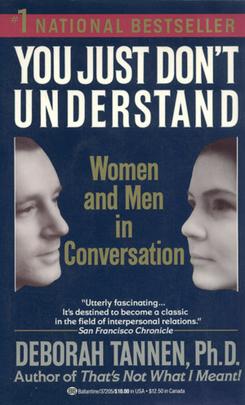Related Research Articles
Sociolinguistics is the descriptive study of the interaction between society, including cultural norms, expectations, and context and language and the ways it is used. It can overlap with the sociology of language, which focuses on the effect of language on society. Sociolinguistics influences, and is influenced by pragmatics, and is closely related to linguistic anthropology.

Conversation is interactive communication between two or more people. The development of conversational skills and etiquette is an important part of socialization. The development of conversational skills in a new language is a frequent focus of language teaching and learning. Conversation analysis is a branch of sociology which studies the structure and organization of human interaction, with a more specific focus on conversational interaction.

Deborah Frances Tannen is an American author and professor of linguistics at Georgetown University in Washington, D.C. Best known as the author of You Just Don't Understand, she has been a McGraw Distinguished Lecturer at Princeton University and was a fellow at the Center for Advanced Study in the Behavioral Sciences following a term in residence at the Institute for Advanced Study in Princeton, New Jersey.

Men Are from Mars, Women Are from Venus (1992) is a book written by American author and relationship counselor John Gray. The book states that most common relationship problems between men and women are a result of fundamental psychological differences between the sexes, which the author exemplifies by means of its eponymous metaphor: that men and women are from distinct planets—men from Mars and women from Venus—and that each sex is acclimated to its own planet's society and customs, but not to those of the other. One example is men's complaint that if they offer solutions to problems that women bring up in conversation, the women are not necessarily interested in solving those problems, but talking about them. The book asserts each sex can be understood in terms of distinct ways they respond to stress and stressful situations.
Assertiveness is the quality of being self-assured and confident without being aggressive to defend a right point of view or a relevant statement. In the field of psychology and psychotherapy, it is a skill that can be learned and a mode of communication. Dorland's Medical Dictionary defines assertiveness as:

A speech community is a group of people who share a set of linguistic norms and expectations regarding the use of language. The concept is mostly associated with sociolinguistics and anthropological linguistics.

That's Not What I Meant! How Conversational Style Makes or Breaks Relationships is Deborah Tannen's first book presenting, for a general audience, her linguistic approach to explaining how ways of speaking affect relationships. Predating by four years her phenomenally bestselling book about gender differences in ways of speaking, You Just Don't Understand, this book approaches communication and miscommunication from a linguistic point of view rather than a psychological one, emphasizing differences between the genders. The book lays out the linguistic devices and rituals that constitute "conversational style", such as indirectness, pacing, pausing, humor, overlap, and interruption, and shows their effects when styles differ.
Muted Group Theory (MGT) is a communication theory developed by cultural anthropologist Edwin Ardener and feminist scholar Shirley Ardener in 1975, that exposes the sociolinguistic power imbalances that can suppress social groups' voices.
Variation is a characteristic of language: there is more than one way of saying the same thing in a given language. Variation can exist in domains such as pronunciation, lexicon, grammar, and other features. Different communities or individuals speaking the same language may differ from each other in their choices of which of the available linguistic features to use, and how often, and the same speaker may make different choices on different occasions.
Feminism is a broad term given to works of those scholars who have sought to bring gender concerns into the academic study of international politics and who have used feminist theory and sometimes queer theory to better understand global politics and international relations as a whole.
Research into the many possible relationships, intersections and tensions between language and gender is diverse. It crosses disciplinary boundaries, and, as a bare minimum, could be said to encompass work notionally housed within applied linguistics, linguistic anthropology, conversation analysis, cultural studies, feminist media studies, feminist psychology, gender studies, interactional sociolinguistics, linguistics, mediated stylistics, sociolinguistics, and feminist language reform and media studies.
Complimentary language is a speech act that caters to positive face needs. Positive face, according to Brown and Levinson, is "the positive consistent self-image or 'personality' claimed by interactions". Many studies examine complimentary language in relation to gender because of the noticeable differences in compliment topic, explicitness, and response depending on gender of the speaker as well as the gender of the addressee. Analysts use these studies to demonstrate their theories about inherent differences between the genders and the societal impact of gender roles.
LGBTQ linguistics is the study of language as used by members of LGBTQ communities. Related or synonymous terms include lavender linguistics, advanced by William Leap in the 1990s, which "encompass[es] a wide range of everyday language practices" in LGBTQ communities, and queer linguistics, which refers to the linguistic analysis concerning the effect of heteronormativity on expressing sexual identity through language. The former term derives from the longtime association of the color lavender with LGBTQ communities. "Language", in this context, may refer to any aspect of spoken or written linguistic practices, including speech patterns and pronunciation, use of certain vocabulary, and, in a few cases, an elaborate alternative lexicon such as Polari.

You Just Don't Understand: Women and Men in Conversation is a 1990 non-fiction book on language and gender by Deborah Tannen, a professor of sociolinguistics at Georgetown University. It draws partly on academic research by Tannen and others, but was regarded by academics with some controversy upon its release. It was written for a popular audience, and uses anecdotes from literature and the lives of Tannen and her family, students and friends.
Interactional sociolinguistics is a subdiscipline of linguistics that uses discourse analysis to study how language users create meaning via social interaction. It is one of the ways in which linguists look at the intersections of human language and human society; other subfields that take this perspective are language planning, minority language studies, quantitative sociolinguistics, and sociohistorical linguistics, among others. Interactional sociolinguistics is a theoretical and methodological framework within the discipline of linguistic anthropology, which combines the methodology of linguistics with the cultural consideration of anthropology in order to understand how the use of language informs social and cultural interaction. Interactional sociolinguistics was founded by linguistic anthropologist John J. Gumperz. Topics that might benefit from an Interactional sociolinguistic analysis include: cross-cultural miscommunication, politeness, and framing.
The Japanese language has some words and some grammatical constructions associated with men or boys, while others are associated with women or girls. Such differences are sometimes called "gendered language". In Japanese, speech patterns associated with women are referred to as onna kotoba or joseigo, and those associated with men are referred to as danseigo.

Turn-taking is a type of organization in conversation and discourse where participants speak one at a time in alternating turns. In practice, it involves processes for constructing contributions, responding to previous comments, and transitioning to a different speaker, using a variety of linguistic and non-linguistic cues.
The principle of male as norm holds that grammatical and lexical devices such as the use of the suffix -ess specifically indicating the female form, the use of man to mean "human", and similar means strengthen the perceptions that the male category is the norm, and that corresponding female categories are derivations and thus less important. The idea was first clearly expressed by 19th-century thinkers who began deconstructing the English language to expose the products and footings of patriarchy.
An interruption is a speech action when one person breaks in to interject while another person is talking. Linguists, social psychologists, anthropologists, and sociologists are among the social scientists who have studied and identified patterns of interruption that may differ by gender, social status, race/ethnicity, culture, and political orientation.
Prosody is an essential part of spoken language, and learners need often need help to perceive and produce the prosody of a new language. Prosody is, today, undertaught. The improvement of prosody teaching is an active research area.
References
- Tannen, Deborah (1990). You Just Don't Understand: Women and Men in Conversation. Virago Press. ISBN 1-85381-471-7.
- Talbot, Mary M. (1998). Language and Gender: An Introduction. Polity Press. ISBN 0-7456-1680-1.
- Sunderland, Jane (2006). Language and Gender: An advanced resource book. Routledge. ISBN 0-415-31103-9.
- Moore, Richard (2003). "Deborah Tannen and difference". teachit.co.uk. Archived from the original on 2021-04-16. Retrieved 2012-01-25.
- Coates, Jennifer (1986). Women, Men and Language: A Sociolinguistic Account of Gender Differences in Language. London: Longman.
- Kelley, Rhonda H. (2012). "Communication between Men and Women in the Context of the Christian Community". The Council on Biblical Manhood and Womanhood. Retrieved 2012-01-25.